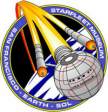 |
 |
 |
Klingon D7 Cruiser
![]() Diagrams
Diagrams![]()
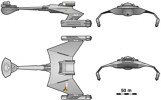 Orthographic views |
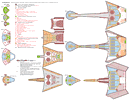 Deck plans, part 1 created by Allen Rolfes (see notes) |
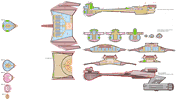 Deck plans, part 2 created by Allen Rolfes (see notes) |
![]() Scenes
Scenes![]()
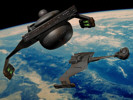
D7s
in orbit
created by Torsten Loeskow
![]() History
History![]()
The D7-class cruiser, which was to become the symbol of Klingon military power in the second half of the 23rd century, was introduced during a time of political change following almost 100 years of continuous galactic conflict. Rushed into service in the early 2250s to fulfill roles of offense, defense, and diplomacy, the D7 suffered numerous teething problems but developed into the Klingons' most reliable cruiser design, which formed the basis for descendant classes serving into the late 24th century.
By the late 2240s, the strategic relationship between the Klingons and the Federation had begun to stabilize and come to more closely resemble the mature relationship of today. Although each side might blockade enemy star systems or make occasional raids to gather intelligence, destroy a threatening enemy base, interdict supply lines, or to obtain an example of some destabilizing new technology, both the Klingons and the Federation recognized that direct invasion by either power for the purpose of territorial conquest was extremely unlikely. A rough strategic parity had been reached so that an invasion attempt by either side would likely end in a quick stalemate. Because the economic, societal, and military costs of total war to both sides, and to the entire galaxy, was too high to contemplate, it was in the best interests of all local powers, both major and minor, that relations between the Klingons and the Federation did not escalate much beyond a cold war or a hot peace.
However, the fact that a policy of accommodation was in the best interests of the Federation, the galactic community, and, arguably, the Klingon themselves is not to say that there was complete agreement on this course of action within the Empire. Some Great Houses, particularly those who wished to gain or solidify their power within the High Council through military honor, continued to insist that only eternal struggle could satisfy the true soul of the Klingon race. Cowering behind well-fortified borders and treating potential Imperial subjects with obsequious respect were anathema to these Klingons. They felt the manifest destiny of the Klingon race was to gain dominion over their arm of the galaxy. Many other Great Houses, although not counseling immediate war, concurred with these sentiments and added that to forever accept current Imperial borders with the Federation was tantamount to surrender. They believed that the Klingon race needed to expand into sectors that held a greater number of habitable planets and exploitable resources to support the ambitions and fulfill the needs of the Klingon people.
While most Klingons agreed that combat and struggle were essential to their race, more-pragmatic Houses realized that the Empire would probably lose an all-out war with the Federation were it to be fought now. (The elusive "Klingon pacifists" long sought out by the Federation turned out to be purely mythical, at least in the 2240s and 2250s. We could not confirm the existence of any Klingon, even those belonging to "scholarly" engineering Houses, who advocated eternal peace with any galactic neighbor. These Houses supported Klingon aggression, since supplying warships to the Imperial Fleet made them essential to the Empire, if not actually respected by other Houses. The Klingon Empire, with a strictly controlled, near-subsistence-level civilian economy and a population barely one third that of the Federation, lagged far behind in industrial capacity, domestic infrastructure, natural resources, agricultural production, and in nearly all key areas of military technology. According to even the most optimistic forecasts, the Klingon Empire would not reach parity with the Federation for at least 50 years; however, these forecasts required that the Federation economy increase at rates not exceeding current levels. If the Klingon Empire were to expand into richer, more fertile sectors of the galaxy, they would reach parity with the Federation more quickly; however, expansion into areas controlled by the Federation would be difficult, if not impossible, without first achieving military parity. Although a series of lightning military strikes, like those attempted with the D6-class cruiser, might allow the Klingons to seize the territory they coveted, the Federation was unlikely to yield any star systems permanently. Were the Federation to withdraw from an area of space, it would only be to marshal their forces for a counterattack to drive out the temporary occupying forces. Therefore, any Klingon attempts at territorial expansion were unlikely to succeed.
The policy eventually chosen by the High Council in 2247 was clearly a compromise between Houses favoring immediate attempts at expansion into Federation territory and those favoring temporary accommodation with the Federation. Chancellor K'tok had keen political instincts, which had served him well in the tumultuous years after the disastrous attacks of 2244. He recognized that military action of some kind was necessary to placate the more aggressive Houses. If they were not allowed to discharge their energies externally in some way, another civil war might result. (A proposal, perhaps apocryphal, to sublimate these energies through athletic competition was never seriously considered.) Some of these Houses might even attack the Federation without Imperial sanction and provoke all-out war. Therefore, Chancellor K'tok authorized specific military actions necessary to ensure Imperial security and to frustrate any Federation attempts at expanding their territory or influence. To the pragmatists, he promised a moratorium on attempts to invade Federation territory and firm control over the Imperial Fleet, increased efforts to improve domestic infrastructure and the quality of life of nonwarrior strata of society, and a greater emphasis on diplomatic contacts and commercial relations with the Federation and other galactic powers.
The Federation was initially quite puzzled when Klingon foreign policy suddenly shifted in 2247 from the ruthless pursuit of imperialist expansion to intermittent, grudging, and ill-tempered diplomatic engagement. At the time, the very concept of "Klingon diplomacy" might have been considered oxymoronic. To the Klingons of the early 23rd century, "diplomacy" likely meant deceiving negotiating partners until they could be attacked, making extravagant promises that would eventually be broken, or threatening ever more unpleasant and effective means of annihilation to recalcitrant governments. A natural response was to assume that the "new face" of the Klingon Empire was a ruse to lull the Federation into a false sense of security. Although this was true to a certain extent, the Federation could see no advantage in rebuffing Klingon diplomatic overtures. Furthermore, the Klingons seemed to be making genuine efforts, although initially rather clumsy, to become more involved in galactic affairs. They exchanged ambassadors with the Federation and other galactic powers and even attempted to communicate in English, the de facto galactic lingua franca. Robert Fox, dean of Federation diplomats and ambassador to the Court of Kahless from 2272 to 2280, recalls in his memoirs (Pathways to Peace, Oxford University Press, Cambridge, Earth, 2320) many long evenings enduring operatic recitals at Klingon Embassy functions when a young consular officer on Tellar in the late 2240s. However, he also claims to have developed a fondness for bregit lung, a widely avoided Klingon delicacy.
Another facet of Klingon diplomacy would involve the Klingon Imperial Fleet. In the new political environment, Klingon warships were not expected only to threaten hostile powers and project military force, although they would certainly continue to do so. In addition to these traditional roles, the Klingon fleet would be required to "show the flag" to allies, neutral powers, and potential adversaries, to exhibit Klingon military might and to demonstrate the far-reaching influence and power of the Klingon Empire. When a mighty Klingon cruiser made a port call, actual or potential allies and trading partners would feel that they were respected and supported by the powerful Klingon Empire and would benefit from a close, cordial relationship. In such a way, a strong web of diplomatic and commercial relationships might be built and maintained.
Even as the likelihood of invasion decreased, both the Federation and the Klingon Empire found that even the cost of eternal vigilance in the defense of their borders had become extreme. While they had learned that forming an empire (or a federation) was relatively easy, keeping it safe, peaceful, and whole was somewhat more difficult. In 2240, both the Federation and the Klingons required at least five fully-crewed starships to continuously patrol a single 100-ly^3 border sector (at then-current speeds and sensor ranges) and ensure absolute security against attacks or raids. Although this level of security was rarely, if ever achieved, the appearance of a strong defense deterred potential adversaries from attacking and helped foster galactic peace.
In the early 2240s the Klingon Empire had sought to expand its borders at the expense of the Federation. To support this goal, the Klingons built the D6 strike cruiser, which had been designed to attack in large numbers and at extremely high speed across distances of approximately 5 ly. In 2241, the D6 was faster than any ship then in service with Starfleet. However, by the mid-2240s, the military objectives that the D6 had been designed to achieve had been discarded by the Empire. Furthermore, if the Klingons had actually possessed any strategic advantage from the high speed of the D6, it had certainly been lost again to the Federation with the introduction of the Constitution class in 2245. Although extremely fast and well armed, the D6 had an extremely short range. Accordingly, its military roles were rather limited. It could, of course, perform its intended offensive role of attacking nearby star systems. However, in a defensive role, the D6 could only operate from fixed bases to either undertake extremely short patrol cruises or to intercept identified attackers. Therefore, to be effective the D6 needed to be operated in large numbers at great expense.
The Klingons' development and production of the hard-hitting but otherwise limited D6 class reflected a short-sighted focus on imperial expansion to the detriment of long-term imperial survival. The D6's small internal volume and short range meant that this class was completely unsuited for the longer missions of defense and diplomacy required by the new political environment but could not be substantially upgraded. To patrol large sectors of the frontier more economically and less aggressively and to perform other duties supporting their new diplomatic openness, the Klingons would require a new, more-versatile ship able to undertake long-duration cruises far from their homeworld.
In 2245, the Federation, attempting to meet challenges similar to those facing the Klingon Empire's, introduced the Constitution class to perform long-distance missions of defense, exploration, and diplomacy. The Constitution class was a great step forward in starship design. Equipped with photon torpedoes, advanced logic systems, powerful sensors, extensive scientific facilities, and a drive system capable of reaching speeds of wf 9, ships of the Constitution class could make unsupported cruises of no less than 5 years' duration and perform the duties of a wide variety of other ship types. The Constitution class promised to greatly reduce the costs of Federation defense, scientific exploration, and diplomacy.
The Klingons had actually began work on their own long-range cruiser, to be known as the D7, in the mid-2230s, in parallel with work on the D6 strike cruiser. Although the Klingon Empire had been determined to pursue short-term territorial gain through production of the D6, long-range strategic theorists recognized the need for a larger, more generally capable ship to support both defense and diplomacy in the long, hot peace they hoped lay in the Klingons' future. Work on the D7 was suspended in 2237, so that all shipyard capacity could be devoted to the D6 strike cruiser, but was resumed ten years later, in 2247.
Reflecting their parallel development programs, the D6 and D7 bore a strong external resemblance. Both had the characteristic Klingon "hatted head" command hull attached by a long, thin neck to an engineering hull with a rear dorsal impulse block and winglike nacelle supports. However, the D7 was significantly larger in all respects. The command head was deepened to allow installation of a launcher for a new weapon, the photon torpedo, to replace the traditional disruptor cannon. The "hat" was widened to house more extensive command and control facilities and larger staterooms for officers and diplomatic guests. The connecting neck was made considerably thinner and longer, but the greatest change was in the engineering hull, which had more than twice the volume of that of the D6. The larger engineering hull allowed the installation of more generous crew facilities. Although mess areas, crew quarters, common rooms, and training halls were made larger and could support 400 crewmen and assault troopers on missions lasting up to 1 year, they were still typically spartan and lacked "nonessentials."
The most significant addition to the engineering hull of the D7 was a new warp power generation system that revived the concept of brak'lul (anatomic redundancy) used in earlier Klingon cruisers. A serious, albeit intended, shortcoming of the D6 was its relatively poor performance at distances greater than 10 ly. The matter/antimatter (M/AM) reactor had been optimized for performance at high output levels for short periods of time without the support of a secondary fusion reactor. Such a system was acceptable for the D6 in its role as a short-range strike cruiser (and as point-defense cruiser) but was unsuitable for a ship required to cruise hundreds of light-years from its home base. Although Klingon reactors of native design had improved greatly since first being used in the D5 cruiser of 2225, concerns about reactor reliability lingered, especially since D7s were expected to undertake missions of such long range.
The solution to this problem was relatively simple. Rather than mounting a single large M/AM reactor with a back-up fusion reactor, the D7 carried two smaller M/AM reactors. Although the dual-reactor system was associated with slight weight and performance penalties owing to the necessary doubling of the reaction chamber, control mechanisms, monitoring stations, core shielding, and power conduits, they were significantly less than if a large fusion reactor and its fuel had been carried for use only in rare emergencies. Furthermore, this dual M/AM reactor system was theoretically more reliable because the ship could operate at more than 50% of standard performance levels with a single reactor, and the likelihood of both reactors simultaneously developing malfunctions was small.
The nacelles were a further refinement of the high peak-output type used on the D6. However, they were of considerably narrower beam and featured easily swapped-out warp coils allowing rapid, routine refurbishment. The nacelles were attached to the secondary hull by thick wings, which were now of an "overcranked" configuration with forward-swept outer panels carrying large emergency plasma flush vents.
The D7 cruiser was a basically sound design but, unfortunately, was rushed into service because the only other ships even marginally suitable for its missions were the 25-year-old D5 cruisers. Ideally, the D7 class would have been introduced sometime in the mid-2250s; however, the lead ship, IKS Klolode, joined the Imperial Fleet in 2250. This too-early introduction meant that several problems that normally would have been encountered and solved in the laboratory during development were instead to be dealt with by engineers in the field. The most pressing problems, as might be expected, were with the new photon torpedo system and the dual-reactor system. The problems with the photon torpedo were the same that had already delayed its introduction by some 20 years: achieving a complete, simultaneous reaction of the entire warhead and targeting at supraluminal speeds. More often than not, a portion of the warhead would react fractions of a millisecond earlier than the rest of the warhead, leading to a still substantial, yet significantly submaximal, detonation. While such a detonation was usually powerful enough to destroy unshielded targets, it could not reliably penetrate the shielding of Federation or Romulan warships. The problem of supraluminal guidance was not as serious, as the Klingons had been using faster-than-light atomic missiles and low-yield antimatter missiles for more than 50 years. However, as the speeds of ships and torpedoes increased, so did the inaccuracy and error introduced by imprecise targeting. Although these problems would eventually be overcome, Klingons captains were frustrated by low success rates in initial trials against shielded targets moving at high warp speeds.
The problems with the dual M/AM reactor system involved coordinating rates of plasma production by and flow from the two reactors. In all previous Klingon reactor systems, only a single reactor—either a fusion reactor or a M/AM reactor—provided power to both nacelles at any one time. However, the D7 used two M/AM reactors operating simultaneously to power the nacelles. If each reactor had powered a single nacelle, the problems of precisely balancing the output of the two reactors and, accordingly, coordinating the warp fields produced by the two nacelles would have been substantial, but not insoluble, at least in theory. However, both reactors would always need to be operated to supply plasma to both nacelles and allow warp flight. Since the express purpose of having a dual-reactor system was to enable both nacelles to be powered by either a single reactor or both reactors, the D7's designers chose to channel plasma from the reactors into a central chamber from which plasma could be distributed symmetrically. This arrangement presented rather difficult plasma-flow problems, particularly the blending of the two plasma streams. The solution was to install a pair of linked step-down temperance valves before the central reservoir to reconcile the plasma streams before joining. Once the two streams had mixed, the single plasma stream could pass through a matrix-buffered augmentation step-up gate before being distributed symmetrically to the two nacelles.
Each section in this rather complex circuit introduced a potential point for plasma rupture and a catastrophic malfunction. In fact, as many as three early D7s were lost in this way, leading to an urgent recall of all other ships for emergency refit. Such problems would likely have been uncovered during extensive ground-based reactor tests during the standard developmental process. However, the unwise decision to expedite delivery of D7s led to these problems appearing only after ships had already entered service. After these teething problems were solved in the early 2250s, the rugged, workmanlike engineering typical of 3rd-generation Klingon reactors proved highly reliable, if not as elegant or advanced as Federation designs.
Service History
The D7-class cruiser became the symbol of Klingon military power in the latter half of the 23rd century. By far the Klingons' most rugged and long-lived design, the D7 was continuously in production from 2250 to 2269, when it began to be replaced by the K't'inga-class cruiser, an upgraded version of the D7. In all, some 300 D7s were constructed. Some of these original D7s were in service as late as the 2340s.
The D7 will forever be paired with Starfleet's Constitution class, its adversary countless times during the Klingon-Federation Cold War of 2247 to 2293. Although they never actually faced each other in decisive combat, at almost any hotspot during this period the appearance of one indicated the imminent arrival of the other. As had been intended, the D7 was an extremely important tool in Klingon diplomatic and military policy. Whenever the Klingon Empire hoped to put pressure on a reluctant would-be ally, to pledge eternal friendship for an unstable planetary regime, or to display its "grave concern" in an area of galactic conflict, a D7 cruiser was likely to be dispatched. When that occurred, the Federation was likely to send a Constitution-class ship in kind. However, despite numerous border incidents and threats of war, the only formal hostilities between the respective governments was the extremely short Four Days' War of 2267, and nearly all engagements between these ships were abortive or inconclusive.
Starfleet officers and Academy cadets, civilian analysts, and armchair admirals have long debated the outcome of combat between Constitutions and D7s. Each ship has its supporters. The Constitution class was slightly faster (wf 9.1) than the D7 (wf 8.5), but absolute speed is rarely the final arbiter in combat. Federation technology of the time was generally superior in the fields of M/AM reactors, sensors, countermeasures, M/AM munitions, weapons targeting, logic systems, energetic shielding, and damage control. In addition, Starfleet crews were generally better trained and disciplined than Klingon crews. The D7 had somewhat better acceleration and maneuverability at both warp and impulse speeds and, in the words of one Starfleet analyst, "handled like a scoutship." Klingon photon torpedoes were generally of higher yield than those of Starfleet, in part to compensate for their inferior speed and accuracy.
However, we must remember that Constitution was not primarily or even predominantly a warship, so cannot be directly compared with the D7. Unlike the Klingon Imperial Fleet, Starfleet was both a military and scientific organization. Accordingly, Constitution-class ships carried extensive laboratories and research facilities to engage in a wide range of scholarly activities (including astronomy, planetary geology, exobiology, xenoethnography, archeology, history, and linguistics) that the Klingons almost completely ignored. Research and scientific specialists not directly involved in the operation of the ship's systems accounted for some 30% of a Constitution's crew. Constitution-class ships were able to cruise without support for approximately five years, whereas the D7's duration was little more than one year. Of course, these personnel and facilities increased the ship's dimensions and displacement and decreased acceleration and maneuverability at both warp and impulse.
These differences would likely have affected the outcome of combat, but any competent captain would have compensated in some way for any disadvantage. Great commanders, such as Garth, April, and Decker of Starfleet and Kang, Koloth, and Kuri of the Klingon Imperial Fleet would regularly find ways to turn disadvantages to advantages through a combination of cunning, experience, and daring. Therefore, the question of which ship was superior remains unresolved.
In the year 2262, the Klingons and the Romulans entered into an agreement whereby Romulan cloaking technology and raw materials would be exchanged for Klingon warships and M/AM technology. The other particulars of this treaty are unclear but appear to include a nonaggression clause if not an actual peace agreement. The Romulans continued to use Klingon-type M/AM reactors until the introduction of quantum-singularity-based power sources sometime in the 2300s. Although Starfleet developed methods of defeating the cloaking device after obtaining one directly from a Romulan D7 through a covert operation in 2268, the Klingons readily adapted and improved the cloaking device for their own ships, most famously for the B'rel-class "Bird of Prey," which continues to serve with the Klingon fleet.
An unusual weapon developed by the Klingons was a projectable stasis field, which could neutralize all high-order field and warp functions, including the warp and impulse drives, energetic shielding, phasers, and photon torpedoes, but left the affected ship otherwise intact. However, as with many other types of exotic weaponry, the energy required to project and maintain the stasis field was so great that the projecting ship was itself rendered nearly as powerless for several hours after the device was used. The practicality of this weapon is unclear, but it might have been intended to enable Klingon soldiers to board a paralyzed enemy ship to seize prisoners or to fight the crew hand-to-hand with traditional Klingon weapons, such as bat'leths and mek'leths. The stasis field projector was used only once against a Federation ship, USS Enterprise, by IKS OghwI in 2270.
IKS T'kek, a D7-class cruiser presented to the Federation by the Supreme Admiral (commander-in-chief) of the Klingon Imperial Fleet in 2293 to mark the signing of the Khitomer Accords, is on display at the Starfleet Museum.
![]() Specifications
Specifications![]()
Standard displacement: 125,000 t
| Overall | 1° Hull | 2° Hull | Nacelles | |
| Length [m] | 228.02 | 45.24 | 171.35 | 77.84 |
| Beam [m] | 160.23 | 50.70 | 159.03 | 12.20 |
| Draft [m] | 66.48 | 33.36 | 345.92 | 20.13 |
Complement: 440
Weapons: 4 disruptor cannons, 1 photon torpedo tube with 96 "Tackle" photon torpedoes
Velocity: wf 6.0, cruise; wf 8.1, supercruise; wf 8.5, maximum
Units commissioned: 300
![]()